|
MY FAVOURITE METHOD BOOKS & TEACHING
RESOURCES
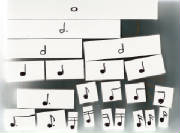
RHYTHM RODS: These rhythm rods are great for smaller children who don't easily understand fractions as well as
for advanced students working on correct grouping for different time signatures. Placing the notes into groups that
equal the length of a beat or a bar makes grouping rules so much easier to understand!
You can make these from cardboard or make more solid bulding blocks like mine. My father is a kitchen manufacturer
and the white board they use on the interiors of kitchen cupboards is strong and inexpensive. He simply cut a piece
of left over board into 1 inch strips and then divided each strip into halfs, quarters, eigths, etc. It only took about
15mins so even if you had to pay for the time and board they would still be a cost effective resource. I then drew notes
on one side of each block and rests on the other with a permanent marker. My blocks measure: semibreve 8", minim 4",
crotchet 2", quaver 1", semiquaver 1/2", dotted minim 6", dotted crotchet 3", dotted quaver 1 1/2". You will need
to make extras of some of the smaller notes so that you have enough for every combination. When you draw on the semiquavers
and quavers make a variety of beam shapes (like in the picture above). You may also want to make some blocks with
time signatures on.
MUSIC MAT: Having a 5 line music stave on the floor that is large enough to stand on each space or line note is
a great way to learn music notes and concepts. This is especially valuable for learning concepts of up & down/high
and low and steps & skips. To physically walk through the music alphabet or to skip from one space to the next jumping
over the lines can be of great benefit to students who are struggling with learning to read and write music! My mat
is made from a sheet sewn in half and electrical tape stuck on to make the lines. You could also use a plastic sheet
and permanent marker, or simply have masking tape or pieces of strings or fabric that you lay out on your floor. I would
love in a brand new studio to build this pattern into the floor tiles!

I Find flashcards invaluable at almost every lesson to teach new notes & check recognition of
old notes. I encourage all parents to purchase a set for at home. Students should be able to name the notes as
fast as you can turn the cards! Students who don't know their notes learn very slowly, have trouble learning new
songs and get bored and quit!

HAL LEONARD PRACTICE NOTEBOOK: I have found these practice notebooks invaluable, they are small, inexpensive and have room
to write each weeks work to be practiced, music stave for any exercises and a space for each day of the weeks practice time.
Don't be shocked when you first see your pupils practice times and realise even your best students don't practice as much
or as regularly as you would have thought.
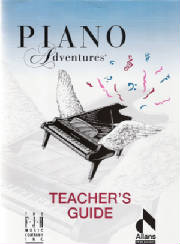
PIANO ADVENTURES SERIES: This is by far the best series of method books I have ever used for teaching piano!!!
In the past I have always used a combination of many different method books, picking and choosing to suit different students
needs, ages and to get a variety of music styles, technique, theory, etc. I didn't think it could be done, but this
method really DOES IT ALL!! It has replaced many of my other books!
Why do I love it so much?
* Its fun! All the lesson books come with CD accompaniments and the songs cover a wide variety of styles including
clasical, jazz, blues, rock & picture pieces that really capture in sound a mood or theme. The authors really
are fantastic composers, the tunes are catchy and yet I don't get sick of hearing them.
* Piano Adventures is based on a very sound teaching methodology that stresses the importance of good piano technique
from the very beginning (something older methods stressed and many newer ones left out!). The black key approach at
the begining of the primer book ensures that students can find letter names all over the piano and this combined with use
of different fingering ensures students don't get locked in to thinking only in set hand positions, a fault of many other
methods.
* The series is written by teachers who understand how children of all different ages think. The explanations
and examples are given in language that is both creative to capture interst and also very age appropriate. Many other
method books leave explanation of theory and technique to the teacher which means it isn't in the book to go over a second
time at home or for a parent who wasn't at the lesson to read over. For teachers these explanations are great
also, I have learnt many new ideas and ways of explaning things!
* It covers everything!! Technique and Artistry books give more in depth exercises and studies
than there is room for in the lesson books. The Theory books are a real treat as they also incorporate Sight Reading
& Aural exercises!!! Both of which as teacers we struggle to fit into regular lessons but are vital to steadily
develop and are key components of most exams. I have previously adopted a more serious approach to theory and not used
theory books that go along with a piano method, but these I am using with the lower levels and am seeing great results
in all round musical development.
* Popular Books - At each level there is a wealth of supplementary material including popular books with
beautiful arrangements of well known movie themes, hit songs, jazz classics, etc. These are really up-to-date including music
from Harry Potter, Lord othe Rings, Mariah Carey, etc. Some of these are published under the titles Pre Time, Play Time,
Show Time, Chord Time, Fun Time, Big Time which correspond with each level fo the Piano Adventures series.
* For all ages - I have now used the Accelerated Beginner books for the 9 - 12 age group and am even
more thrilled with the Adult book. The pace of learning is perfect for each and the adult book takes a much more overall
conceptual approach to introducing new ideas. Almost all the songs in the adult book are tunes the student
will know, drawing on their musical background in complete contrast to the Very Young Beginner book where mood pieces
(e.g. songs that sound like a Horse, or a Juggler) will be more enjoyed by the age group. Singing along is
something 5 & 6 year olds will naturally enjoy and so the Very Young beginner book has a CD which sings
the lyrics.
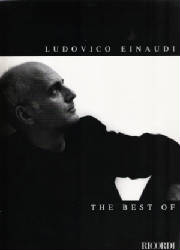
LUDOVICO EINAUDI is the composer of some of the best piano music I have ever enjoyed listening to and playing!
I love being able to give students something to play written by a current day composer. Einaudi's music is breath takingly
beautiful, thoughful, deep, energetic, melodic and written for a grade 4 - 5 level! The notes and rhythms are not hard
to learn, but putting in the feeling and expression requires a big leap in technique and musical appreciation for most of
my students. If you haven't heard of Einauid search him out on the net or go and buy and album. His music has
the unusual quality of being incredibly relaxing background music and yet when you really listen to it with the volume up
you learn something new every time in the way he develops his melodies. My favourite songs are 'I Giorni', 'Bella Notte'
and 'In un Ultra Vita'.

WATERNMAN PIANO LESSONS - This series is the best classical piano method I have found. It systematically teaches the scales
& technique through varied exercises, required to play each piece of music. It is incredibly thorough and excellent exam
preperation.

ALFREDS BASIC PIANO LIBRARY - TOP HITS SOLO'S (Levels 1A - 6): These really have been a HIT with all my pupils. Standard
Classics, Disney Themes, TV Themes, Broadway Songs and all very recent. Each Level is extremely well graded, and each book
progresses in difficulty from beginning to end making them excellent supplementary material. Songs include: Beauty &
The Beast, Titanic Theme, Casper the Friendly Ghost, Mission Impossible Theme, Axel F, Edelweise, Rubber Duckie, Nadia's Theme,
Popey, Can you Feel the Love Tonight, A Whole New World, The Adams Family Theme, . . .
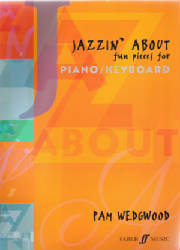
JAZZIN' ABOUT: Pam Wedgwood is one of the UKs best known teacher/composers and pieces from this series of books are
regularly used in Trinity Guildhalls examination syllabus' for both violin & piano. The songs are written in
a variety of popular styles including: jazz, blues, rock & funk. The melodies and chord patterns are catchy
and the tunes have a familiarity when you hear them, like you have heard it before, or at least something very similar!
This makes the songs instantly appealing to students while at the same time the composer has incorporated a wealth of
technical development and interesting rhythmic patterns. The Series includes Easy Jazzin' About Piano (Grades 1 - 2),
Jazzin' About Piano (Grades 3 - 4), After Hours Jazz (Grades 5), Really Easy Jazzin About Violin, Jazzin About Violin,
After Hours Violin (with CD), and heaps more for other instruments, duets, etc. You may also want to check
out Pam Wedgwood's 'UpGrade' Series specifically designed to bridge the gap between exam levels (e.g. Upgrade 2 - 3).
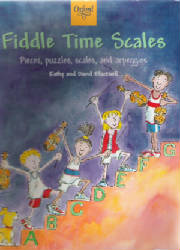
THE FIDDLE TIME SERIES: Fiddle Time Starters, Fiddle Time Joggers, Fiddle Time Runners, Fiddle Time Sprinters &
Fiddle Time Scales books 1 & 2. I am continually amazed by the wonderful creativity of teachers to compose songs
for beginner students who can only play a few notes! They sound like complete songs from the very beginning! All
the books except the Fiddle Time Scales have backing CDs recorded by the composer with groups of live instruments and they
have a very 'real' feeling like you are playing along with a group of other students. The songs are lively and catchy!
You can start with the Fiddle Time Joggers or for younger students use the Fiddle Time Starters as a preparatory book first.
The teaching method is sound, introducing 1 new finger at a time and thoroughly working with it across all the strings before
introducing the next finger. The tempo (speed) of the songs and difficulty of bowing, string changes, etc
places a strong emphasis from the beginning on developing musical ability, control of tone, and performance technique,
rather than just learning new notes. Several of the songs in these books are included in the current
Trinity Guildhall Violin syllabus at grade 1 - 3 level. I use the Fiddle Time Scales books with all my students
regardless of what method they are learning from. Each new scale is introduced with the scale written out in full, the
arpeggio, and a finger diagram that is left blank for the students to fill in the letters. A new rhythmic pattern is
also introduced at the bottom of each scale page. Then on the facing page, there are 1 or 2 short songs using that key
and rhythms.
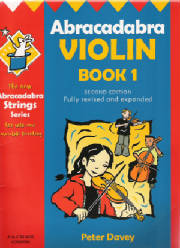
ABRACADABRA like all the other violin methods I recomend comes with a play-a-long CD. For young violinists to be
able to attain good intonation (tuning) they need a reference point, something to compare there performance with and see if
it matches! To an untrained ear a song can sound ok and like it is in tune, but then when you play it with the CD most
students can easily hear where theirs doesn't match what is on the recording! Abracadabra is a "popular" method made
up completely of well knwn tunes, nursery rhymes, film & tv music, etc. It is an actual method book introducing
each note and new tehcnique one by one, not just a collection of popular songs. Songs include: Mary Had a Little
Lamb, Lightly Row, Hot Cross Buns, Flintstones, Edelweiss, Part of Your Wolrd (from the Little Mermaid), Beuaty & the
Beast, Roses from the South, Old MacDonald. Older beginners and adults especially like to play tunes that they already
know!
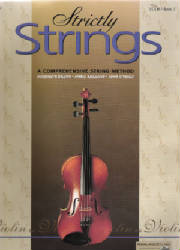
STRICTLY STRINGS: Books 1 & 2 of Strictly Strings have an accompanying CD. This is a great standard violin
method! I use book 2 with most of my students before sitting a grade 2 exam. Each page introduces new concepts
of fingering, bowing, or performance at the top, and then gives several exercises to teach these. This is usually followed
by 2 or 3 short songs incorporating this same material. The songs are a mixture of classical themes and well known traditional
tunes. These books also have several performance pieces that are full length songs with a duet part for a second violin.
The books are also available for Viola, Cello & Double Bass making full orchestra parts for these performance songs.
My favourite song is "Classical Bash" which is a medley of Mozart's Eine Kleine Nacht Musik, Haydn's Surprise
Symphony, and Beethoven's Ode to Joy, stuck together with the recurring theme of Beethoven's 5th Symphony!
This series also has other supplementary books with orchestra and ensemble pieces that I have found useful for my four violin
string quartet.
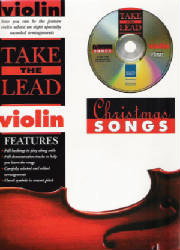
TAKE THE LEAD is just one example of the various play-a-long albums available for solo isntruments. These kinds
of supplementary albums get students really inspired to play for fun! The backing CDs usually have 2 tracks for each
song, 1 with the violin playing and the second as just a backing track, ideal for busking and other performances. Each
series has a variety of albums, some of the ones I have seen are: Movie Hits, 90's Hits, TV Themes, Christmas, Abba, Blues
Bros, Clasical themes, etc. Encourage students to go to their local music shops and find albums like this that they
are interested in!
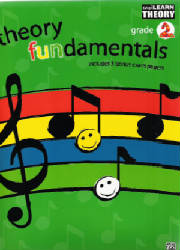
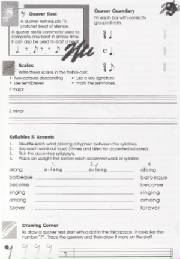
THEORY FUNDAMENTALS is the BEST!!!! Theory method I have ever used! The downfall of most theory books is that they
teach a whole chapter on just one topic at a time with very little revison of topics already taught. I often have students
that get to the end of these books and have forgotten the earlier topics, or do a whole topic wrong and then i have to find
extra exercises for them to practice to fix the problem! Theory Fundamentals introduces 1 small new thing on each lesson
page and every lesson has an exercise on each of the topics learnth so far e.g. writing a scale, writing or naming intervals,
a rhythm question, a transposition, a harmony question, etc. With this type of gradual learning and constant revision
students reach the end of the book confidently ready for the tests at the back of the book without extra need for revision.
The gradual approach allows topics to build over a series of weeks rather than in just 1 chapter which allows me more lesson
opportunities to discuss difficult concepts. The method books are also printed a modern and attractice format that is
appealing to students. The only sad thing about this series is that they only go up to grade 3!!
|

